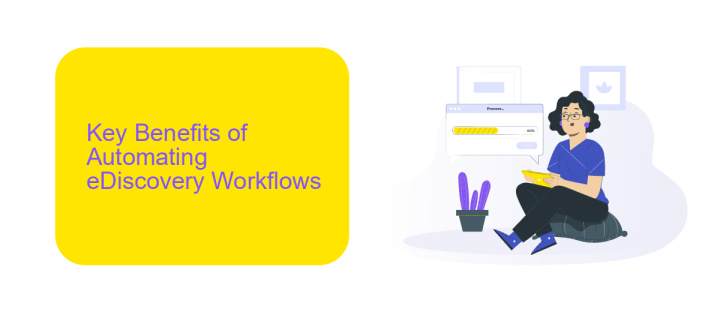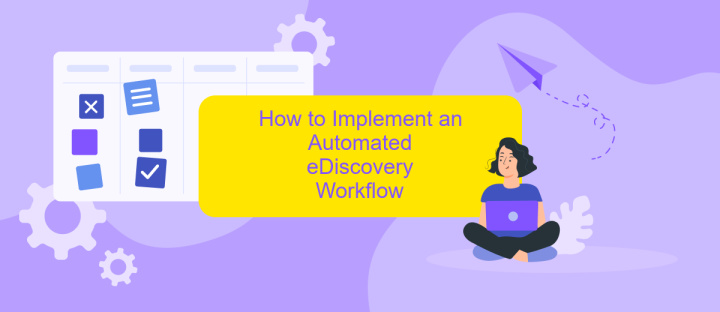eDiscovery Workflow Automation
In the rapidly evolving landscape of legal technology, eDiscovery Workflow Automation stands out as a game-changer. By streamlining the complex and time-consuming processes involved in electronic discovery, it enables legal professionals to manage data more efficiently, reduce costs, and improve accuracy. This article explores the key benefits and best practices for implementing eDiscovery automation in your legal practice.
Introduction to eDiscovery Workflow Automation
eDiscovery Workflow Automation is revolutionizing the way legal and compliance professionals handle electronic discovery processes. By leveraging advanced technologies, organizations can streamline the collection, processing, and review of electronic data, significantly reducing time and costs associated with traditional methods.
- Automated data collection from various sources.
- Efficient data processing and filtering.
- Streamlined document review and analysis.
- Integration with existing legal and compliance tools.
One of the key components of a successful eDiscovery workflow automation is seamless integration with other tools and services. Platforms like ApiX-Drive enable organizations to easily connect and automate data flows between different systems, enhancing the efficiency of the eDiscovery process. By automating repetitive tasks and ensuring data consistency, ApiX-Drive helps legal teams focus on more strategic activities, ultimately improving overall productivity and outcomes.
Key Benefits of Automating eDiscovery Workflows

Automating eDiscovery workflows provides significant advantages, including increased efficiency and reduced costs. By automating repetitive tasks such as data collection, processing, and review, organizations can save valuable time and resources. This allows legal teams to focus on more strategic activities, ensuring a more streamlined and effective process. Additionally, automation minimizes the risk of human error, enhancing the accuracy and reliability of the eDiscovery process.
Another key benefit is the ability to easily integrate various tools and services, optimizing the entire workflow. For instance, platforms like ApiX-Drive facilitate seamless integration between different applications, enabling smooth data transfer and synchronization. This not only improves the overall efficiency of eDiscovery but also ensures that all relevant information is readily accessible and up-to-date. By leveraging automation and integration, organizations can achieve a more cohesive and responsive eDiscovery process, ultimately leading to better legal outcomes.
How to Implement an Automated eDiscovery Workflow

Implementing an automated eDiscovery workflow can significantly enhance your organization's efficiency and accuracy in handling electronic data. The process involves several key steps to ensure a seamless transition from manual to automated processes.
- Assess Your Needs: Identify the specific requirements of your eDiscovery process, including data sources, types of data, and compliance regulations.
- Select the Right Tools: Choose automation tools that align with your needs. Consider solutions like ApiX-Drive for integrating various data sources and automating data collection.
- Develop a Workflow Plan: Map out the entire eDiscovery process from data identification to preservation, collection, review, and production. Define the steps that can be automated.
- Implement and Test: Set up the chosen tools and configure the automated workflows. Conduct thorough testing to ensure accuracy and reliability.
- Train Your Team: Provide comprehensive training to your team on using the new automated system. Ensure they understand both the technology and the updated workflow processes.
By following these steps, you can successfully implement an automated eDiscovery workflow that minimizes manual effort and maximizes efficiency. Leveraging tools like ApiX-Drive can further streamline the integration of various data sources, making your eDiscovery process more robust and reliable.
Challenges and Considerations in Workflow Automation

Implementing workflow automation in eDiscovery presents several challenges and considerations. One of the primary challenges is ensuring data security and compliance with legal standards. Automated workflows must be robust enough to handle sensitive information without compromising confidentiality or integrity.
Another significant consideration is the integration of various tools and systems. Workflow automation requires seamless communication between different software solutions, which can be complex and time-consuming to set up. Services like ApiX-Drive can facilitate these integrations, streamlining the process and reducing potential errors.
- Data Security and Compliance
- Integration of Multiple Tools
- Scalability and Flexibility
- User Training and Adaptation
Finally, scalability and flexibility are crucial for effective workflow automation. As organizations grow and their needs evolve, automated workflows must be adaptable to new requirements and increased data volumes. Additionally, comprehensive user training is essential to ensure that staff can effectively utilize and manage the automated systems.
- Automate the work of an online store or landing
- Empower through integration
- Don't spend money on programmers and integrators
- Save time by automating routine tasks
Future Trends and Best Practices in eDiscovery Workflow Automation
The future of eDiscovery workflow automation is poised to be shaped by advancements in artificial intelligence (AI) and machine learning (ML). These technologies will enable more accurate and efficient data processing, reducing the time and cost associated with eDiscovery. Predictive coding and advanced analytics will become standard tools, allowing legal teams to quickly identify relevant documents and patterns within large datasets. Additionally, the integration of cloud-based solutions will facilitate better collaboration and accessibility, ensuring that teams can work seamlessly from different locations.
Best practices in eDiscovery workflow automation will focus on the customization and integration of various tools to create a cohesive system. Services like ApiX-Drive can play a crucial role by offering easy-to-use integrations that connect different applications and data sources. This will streamline workflows and enhance the overall efficiency of the eDiscovery process. Regular updates and training on new technologies will also be essential to stay ahead in the rapidly evolving landscape of eDiscovery. Emphasizing data security and compliance will remain a top priority, ensuring that sensitive information is handled with the utmost care.
FAQ
What is eDiscovery workflow automation?
How can eDiscovery workflow automation benefit my organization?
What steps are involved in automating the eDiscovery workflow?
Can eDiscovery workflow automation integrate with existing systems?
Is eDiscovery workflow automation secure?
Apix-Drive is a universal tool that will quickly streamline any workflow, freeing you from routine and possible financial losses. Try ApiX-Drive in action and see how useful it is for you personally. In the meantime, when you are setting up connections between systems, think about where you are investing your free time, because now you will have much more of it.


